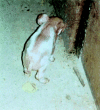The role of Isospora suis as a pathogen in conventional piglet production in Germany
- PMID: 12069269
- PMCID: PMC7165496
- DOI: 10.1046/j.1439-0450.2002.00459.x
The role of Isospora suis as a pathogen in conventional piglet production in Germany
Abstract
In order to evaluate the prevalence of Isospora suis in conventional piglet production in Germany, pooled faecal samples from 327 pig litters from 18 pig production units (20-320 sows each) were examined. At least 10 litters from each farm were investigated. I. suis was present on 83% of the farms and 42.5% of the litters, the infection rate being highest in the third week of age (48.2%). I. suis was found more frequently in samples of diarrhoea than in firm faeces (49.2% compared to 22.2%). Twenty naturally infected piglets from six of these farms underwent examination post mortem, including histology, virology and bacteriology. Histological examination revealed atrophy of the villi in various degrees, mild crypt hyperplasia, fusion of the villi, metaplastic epithelium, erosions and necrosis, especially in the medium and the posterior jejunum and in the ileum. Asexual and sexual developmental stages of the parasite were found in varying numbers in the epithelium of the whole of the small intestine. Bacteria and viruses were mostly excluded as the cause of diarrhoea, and it was concluded that I. suis was the primary pathogen inducing distinct changes and clinical symptoms of diarrhoea.
Figures


Similar articles
-
Occurrence of Isospora suis in larger piglet production units and on specialized piglet rearing farms.Vet Parasitol. 1999 May;82(4):277-84. doi: 10.1016/s0304-4017(99)00027-8. Vet Parasitol. 1999. PMID: 10384903
-
[The epizootiology and pathogenic significance of infections with Isospora suis in ten piglet production operations in Nordrhein-Westfalen].Berl Munch Tierarztl Wochenschr. 1996 Jun-Jul;109(6-7):220-3. Berl Munch Tierarztl Wochenschr. 1996. PMID: 8765537 German.
-
Isospora suis: an experimental model for mammalian intestinal coccidiosis.Parasitol Res. 2006 Jan;98(2):167-75. doi: 10.1007/s00436-005-0030-x. Epub 2005 Dec 2. Parasitol Res. 2006. PMID: 16323027
-
Isospora suis infection in piglets. A review.Vet Q. 1983 Oct;5(4):178-85. doi: 10.1080/01652176.1983.9693894. Vet Q. 1983. PMID: 6359663 Review.
-
Porcine isosporosis: infection dynamics, pathophysiology and immunology of experimental infections.Wien Klin Wochenschr. 2007;119(19-20 Suppl 3):33-9. doi: 10.1007/s00508-007-0859-3. Wien Klin Wochenschr. 2007. PMID: 17987356 Review.
Cited by
-
Prevalence of Isospora suis and Eimeria spp. in suckling piglets and sows in Poland.Vet Parasitol. 2007 Jun 20;147(1-2):171-5. doi: 10.1016/j.vetpar.2007.03.029. Epub 2007 Apr 30. Vet Parasitol. 2007. PMID: 17467906 Free PMC article.
-
Coccidia Species and Geographical Distribution in Genus Sus: A Scoping Review.Microorganisms. 2024 Dec 25;13(1):14. doi: 10.3390/microorganisms13010014. Microorganisms. 2024. PMID: 39858782 Free PMC article. Review.
-
Factors associated with the occurrence and level of Isospora suis oocyst excretion in nursing piglets of Greek farrow-to-finish herds.BMC Vet Res. 2012 Nov 22;8:228. doi: 10.1186/1746-6148-8-228. BMC Vet Res. 2012. PMID: 23174007 Free PMC article.
-
Dependence of the immune response to coccidiosis on the age of rabbit suckling.Parasitol Res. 2008 Nov;103(6):1265-71. doi: 10.1007/s00436-008-1123-0. Epub 2008 Aug 8. Parasitol Res. 2008. PMID: 18688645
-
Absorption and Distribution of Toltrazuril and Toltrazuril Sulfone in Plasma, Intestinal Tissues and Content of Piglets after Oral or Intramuscular Administration.Molecules. 2021 Sep 16;26(18):5633. doi: 10.3390/molecules26185633. Molecules. 2021. PMID: 34577103 Free PMC article.
References
-
- Bergeland, E. M. , 1977: Necrotic enteritis in nursing piglets. Proc. Annu. Meet. Am. Assoc. Vet. Laboratory Diagn. 20 , 151–158.
-
- Chae, C. , Kwon D., Kim O., Min K., Dheon D. S., Chois C., Kim B., and Suh J., 1998: Diarrhoea in nursing piglets associated with coccidiosis: prevalence, microscopic lesions and coexisting microorganisms. Vet. Rec. 143 , 417–420. - PubMed
-
- Current, W. L. , 1987: Neonatal swine coccidiosis. Anim. Health Nutr. 42 , 8–10.
-
- Daugschies, A. , Meyer C., and Joachim A., 1999: Vorkommen von Isospora suis . Ferkelerzeuger- Ferkelaufzuchtbetrieben. Prakt. Tierarzt 80 , 530–537.
MeSH terms
LinkOut - more resources
Full Text Sources
Medical

